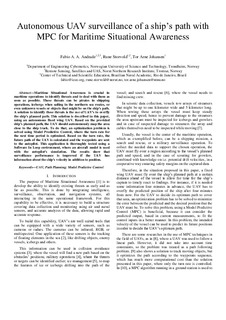| dc.contributor.author | Andrade, Fabio | |
| dc.contributor.author | Johansen, Tor Arne | |
| dc.contributor.author | Storvold, Rune | |
| dc.date.accessioned | 2017-12-14T13:43:02Z | |
| dc.date.available | 2017-12-14T13:43:02Z | |
| dc.date.created | 2017-12-10T14:19:57Z | |
| dc.date.issued | 2017 | |
| dc.identifier.isbn | 978-1-5090-4495-5 | |
| dc.identifier.uri | http://hdl.handle.net/11250/2471916 | |
| dc.description.abstract | Maritime Situational Awareness is crucial in maritime operations to identify threats and to deal with them as soon as possible. These threats can be pirates in shipping operations, icebergs when sailing in the northern sea routes, or even unknown vessels or objects that might be on the ship's path. A solution to identify these threats is the use of UAV's to overfly the ship's planned path. This solution is described in this paper, using an autonomous fixed wing UAV. Based on the provided ship's planned path, the UAV should autonomously map the area close to the ship track. To do that, an optimization problem is solved using Model Predictive Control, where the turn rate for the next time period is optimized. Based on the turn rate, the future path of the UAV is calculated and the waypoints are sent to the autopilot. This application is thoroughly tested using a Software In Loop environment, where an aircraft model is used with the autopilot's simulation. The results show that surveillance performance is improved if the UAV has information about the ship's velocity in addition to position. | nb_NO |
| dc.language.iso | eng | nb_NO |
| dc.publisher | Institute of Electrical and Electronics Engineers (IEEE) | nb_NO |
| dc.relation.ispartof | 2017 International Conference on Unmanned Aircraft Systems | |
| dc.title | Autonomous UAV surveillance of a ship’s path with MPC for Maritime Situational Awareness | nb_NO |
| dc.type | Chapter | nb_NO |
| dc.type | Peer reviewed | nb_NO |
| dc.description.version | acceptedVersion | nb_NO |
| dc.identifier.doi | 10.1109/ICUAS.2017.7991361 | |
| dc.identifier.cristin | 1525314 | |
| dc.relation.project | Norges forskningsråd: 223254 | nb_NO |
| dc.relation.project | EC/H2020/642153 | nb_NO |
| dc.description.localcode | © 2017 IEEE. Personal use of this material is permitted. Permission from IEEE must be obtained for all other uses, in any current or future media, including reprinting/republishing this material for advertising or promotional purposes, creating new collective works, for resale or redistribution to servers or lists, or reuse of any copyrighted component of this work in other works. | nb_NO |
| cristin.unitcode | 194,63,25,0 | |
| cristin.unitname | Institutt for teknisk kybernetikk | |
| cristin.ispublished | true | |
| cristin.fulltext | postprint | |
| cristin.qualitycode | 1 | |
